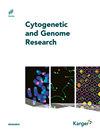会说话的刺鲶鱼Anadoras(Doradidae,Astrodoradinae)的核型进化:由重复DNA的结构重排和重组介导的过程
IF 1.7
4区 生物学
Q4 CELL BIOLOGY
引用次数: 1
摘要
Anadoras是一种多刺的鲶鱼属,广泛分布于亚马逊和巴拉圭河流域。它包括两个名义物种,A.grypus和A.weddellii,以及Anadoras sp.“araguaia”,一个未描述的物种,仅在形态上被识别。由于Anadoras在Astrodoradinae系统发育中占据基础地位,因此确定其细胞遗传学特征对于理解该亚科染色体多样化的机制至关重要。因此,我们对所有种类的Anadoras进行了比较细胞遗传学分析。此外,我们应用基于线粒体细胞色素氧化酶亚基1(CO1)基因600bp的物种划界分析来研究该物种的分类地位。细胞遗传学标记显示,薇氏Anadoras weddellii和Anadoras sp.“araguaia”都有2n=56条染色体(24m+10sm+22st/a),在顶心对28上有单个NOR位点,在亚中心对15上有5S rDNA位点。A.grypus具有最不同的染色体特征,因为尽管它也有2n=56条染色体,但它在染色体公式、异染色质分布和rDNA位点的数量/位置方面表现出一些差异。总之,我们认为Anadoras的染色体多样化是由4种机制引起的:中心融合、中心周/中心旁反转、非互易易位和转座元件的活性。此外,我们的系统发育树揭示了得到充分支持的分支,并通过条形码物种划界分析,确认了3个分子操作分类单元的存在,包括推定的新种Anadoras sp.“araguaia”本文章由计算机程序翻译,如有差异,请以英文原文为准。
Karyotype Evolution of Talking Thorny Catfishes Anadoras (Doradidae, Astrodoradinae): A Process Mediated by Structural Rearrangements and Intense Reorganization of Repetitive DNAs
Anadoras is a thorny catfish genus widespread through the Amazon and Paraguay river basins. It includes 2 nominal species, A. grypus and A. weddellii, plus Anadoras sp. “araguaia,” an undescribed species only recognized morphologically. Since Anadoras occupies a basal position within the Astrodoradinae phylogeny, it is crucial to identify its cytogenetic features to comprehend the mechanisms involved in the chromosomal diversification of this subfamily. Therefore, we performed a comparative cytogenetic analysis including all species of Anadoras. Furthermore, we applied a species delimitation analysis based on 600 bp of the mitochondrial cytochrome oxidase subunit 1 (CO1) gene to investigate the taxonomic status of the species. Cytogenetic markers revealed a high degree of similarity among Anadoras weddellii and Anadoras sp. “araguaia,” both have 2n = 56 chromosomes (24m + 10sm + 22st/a), single NOR sites on acrocentric pair 28, and 5S rDNA sites on submetacentric pair 15. A. grypus has the most divergent chromosomal characteristics because, even though it also has 2n = 56 chromosomes, it exhibits several differences in the chromosome formula, heterochromatin distribution, and number/position of the rDNA sites. In sum, we believe that the chromosome diversification of Anadoras is due to 4 mechanisms: centric fusion, pericentric/paracentric inversions, nonreciprocal translocations, and activity of transposable elements. Additionally, our phylogenetic tree revealed well-supported clades and, by barcode species delimitation analysis, confirmed the existence of 3 molecular operational taxonomic units, including the putative new species Anadoras sp. “araguaia.”
求助全文
通过发布文献求助,成功后即可免费获取论文全文。
去求助
来源期刊

Cytogenetic and Genome Research
生物-细胞生物学
CiteScore
3.10
自引率
5.90%
发文量
25
审稿时长
1 months
期刊介绍:
During the last decades, ''Cytogenetic and Genome Research'' has been the leading forum for original reports and reviews in human and animal cytogenetics, including molecular, clinical and comparative cytogenetics. In recent years, most of its papers have centered on genome research, including gene cloning and sequencing, gene mapping, gene regulation and expression, cancer genetics, comparative genetics, gene linkage and related areas. The journal also publishes key papers on chromosome aberrations in somatic, meiotic and malignant cells. Its scope has expanded to include studies on invertebrate and plant cytogenetics and genomics. Also featured are the vast majority of the reports of the International Workshops on Human Chromosome Mapping, the reports of international human and animal chromosome nomenclature committees, and proceedings of the American and European cytogenetic conferences and other events. In addition to regular issues, the journal has been publishing since 2002 a series of topical issues on a broad variety of themes from cytogenetic and genome research.
 求助内容:
求助内容: 应助结果提醒方式:
应助结果提醒方式:


